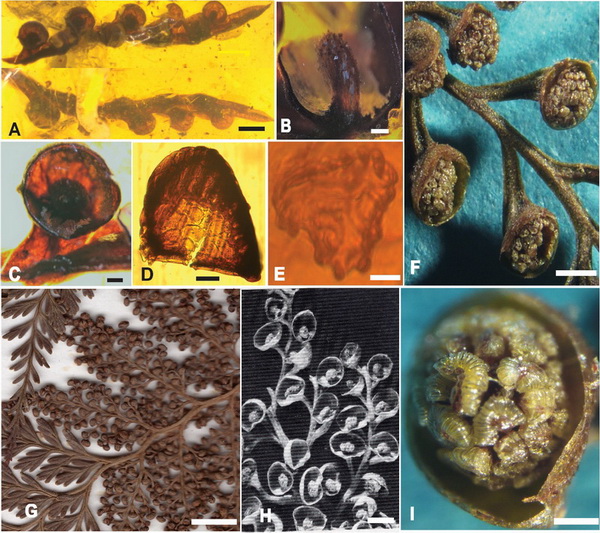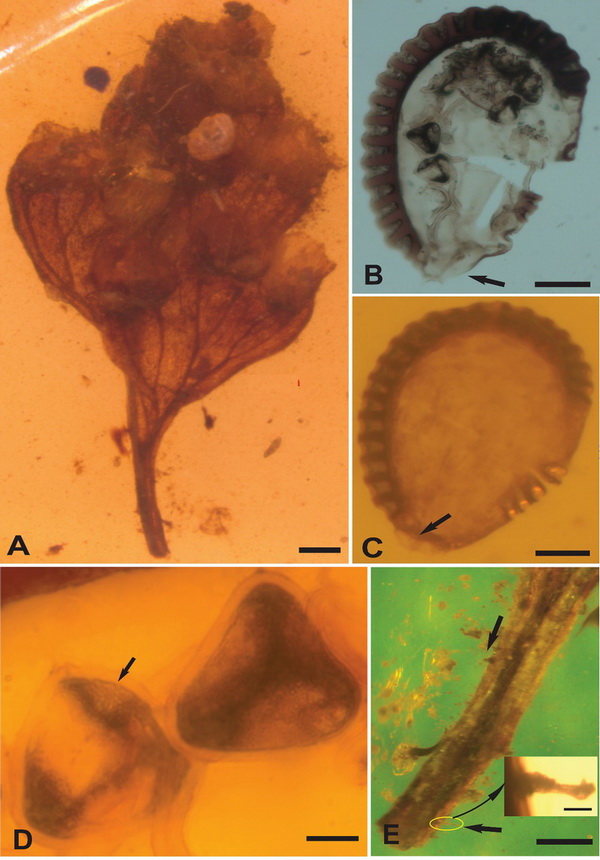Numerous well-preserved fossils have already been discovered in mid-Cretaceous (late Albian to earliest Cenomanian, ≈100 Ma) amber from northern Myanmar, including new species, genera, and even families of plants and invertebrates. Compared to many new discoveries on insects, researches of the botanical inclusions stay faraway behind, so far only a few derived ferns (polypods) described from the Myanmar ambers. However, the polypod fossils are significant not only in recovering the polypod ferns’ diversity changes in history, but also in bridging the gap between the Cretaceous records of polypod ferns and divergence time estimates obtained based on the DNA sequence variation.
For ferns, amber inclusions are scientifically valuable because of their preservation of micro-structures, especially sporangia, which are usually poorly preserved in sedimentary fossils. Two new fern fossils with beautifully preserved sporangia were reported by Prof. LI Chunxiang from Nanjing Institute of Geology and Palaeontology, Chinese Academy of Sciences and her colleagues, from the mid-Cretaceous amber of Myanmar.
Thyrsopteris cretacea represents the first fossil occurrence of Thyrsopteris in the Myanmar tropical forest. Today only one species is known in Thyrsopteris and Thyrsopteridaceae from temperate southern hemisphere and the new fossil species adds much needed data on the evolutive history of this group of ferns. It adds to the diversity previously ascribed to the Thyrsopteridaceae, which has been based on Eocene fossils, and it extends the fossil record of the family further back to the mid-Cretaceous. Most previous fossils of Thyrsopteridaceae have been from the Southern Hemisphere and are therefore considered Gondwanan. Thyrsopteris cretacea represents one of the few occurrences of the family in Laurasia.
Researchers also described another new fossil belonging to the Lindsaeaceae as Proodontosoria myanmarensis gen. et sp. nov.. This new fossil probably scrambled with scandent leaves and spiny axes on other plants. The increasing inventory of the Lindsaeaceae in amber has important implications for the phylogenetic reconstruction of extant Lindsaeaceae lineages and subsequent interpretation of their classification. The morphology of Proodontosoria myanmarensis does not concur with any crown group lineage of Lindsaeaceae, but rather display a character state mosaic of several extant lineages. As a result, the fossil might be a Lindsaeaceae stem group representative, rather than a crown group element.
These researches were supported by Project of State Key Laboratory of Palaeobiology and Stratigraphy (Nanjing Institute of geology and Palaeontology, CAS) (Grant No. Y626040108), and Strategic Priority Research Program of Chinese Academy of Sciences (Grant No. XDB26000000).
References: 1) Chunxiang Li, Robbin C. Moran, Junye Ma, Bo Wang, Jiasheng Hao (2018). A new fossil record of Lindsaeaceae (Polypodiales) from the mid-Cretaceous amber of Myanmar.Cretaceous Research.https://doi.org/10.1016/j.cretres.2018.12.010
2) Chunxiang Li, Robbin C. Moran, Junye Ma, Bo Wang, Jiasheng Hao, Qun Yang (2019). A mid-Cretaceous tree fern of Thyrsopteridaceae (Cyatheales) preserved in Myanmar amber.Cretaceous Research. https://doi.org/10.1016/j.cretres.2019.01.002

Fossil and extant Thyrsopteris. (A–E) Holotype of Thyrsopteris cretacea. (F-I) Extant Thyrsopteris elegans.

Proodontosoria myanmarensis gen. et sp. nov. (Lindsaeaceae, Polypodiales).
